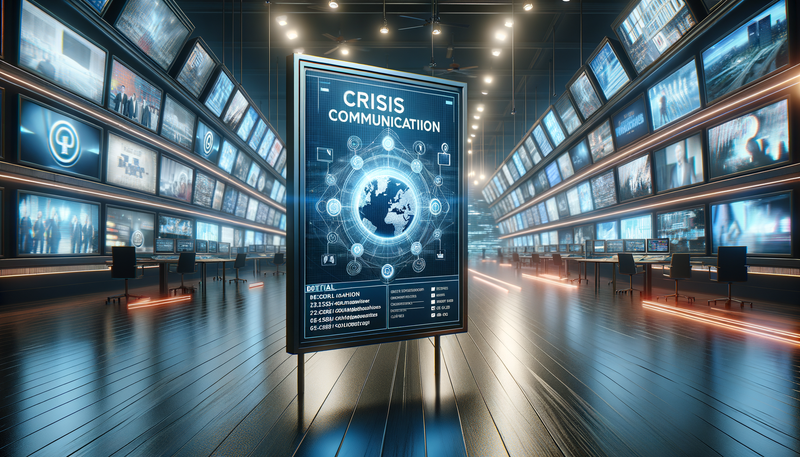Digital Cards for Crisis Communication: Rapid Information Dissemination
In today's fast-paced digital world, effective crisis communication is crucial for organizations to manage emergencies and disseminate critical information quickly. Digital cards have emerged as a powerful tool for rapid information sharing during crisis scenarios. This guide explores the concept of digital cards for crisis communication, their benefits, and how to create and distribute them effectively. By leveraging digital cards, organizations can ensure that vital information reaches their audience promptly, helping to mitigate risks, maintain transparency, and guide people through challenging situations. Learn how to harness the power of digital cards to enhance your crisis communication strategy and keep stakeholders informed during emergencies.Table of Contents:
-
Understanding Digital Cards for Crisis Communication
- Benefits of Using Digital Cards in Crisis Scenarios
- Creating Effective Digital Cards for Crisis Communication
- Types of Crisis Scenarios and Corresponding Digital Cards
- Tools and Platforms for Creating and Distributing Digital Cards
- Best Practices for Digital Card Distribution
- Benefits of Using Digital Cards in Crisis Scenarios
- Creating Effective Digital Cards for Crisis Communication
- Types of Crisis Scenarios and Corresponding Digital Cards
- Tools and Platforms for Creating and Distributing Digital Cards
- Best Practices for Digital Card Distribution

Understanding Digital Cards for Crisis Communication
Digital cards are concise, visually appealing, and easily shareable pieces of digital content designed to convey important information quickly. In the context of crisis communication, these cards serve as bite-sized updates that can be rapidly created and distributed across various digital platforms. They typically include essential details such as situation updates, safety instructions, contact information, and relevant resources.The power of digital cards lies in their versatility and accessibility. They can be easily shared on social media, embedded in websites, sent via messaging apps, or displayed on digital signage. This multi-channel approach ensures that critical information reaches a wide audience promptly, regardless of their preferred communication platform.
Do you need a website? Want to build a website but don't know where to start? Our website builder is the perfect solution. Easy to use, and with the ability to customize to fit your business needs, you can have a professional website in no time.
Benefits of Using Digital Cards in Crisis Scenarios
Digital cards offer several advantages for crisis communication:1. Rapid dissemination: Cards can be created and shared quickly, allowing for real-time updates.
2. Visual appeal: The use of graphics and concise text makes information more digestible and memorable.
3. Mobile-friendly: Digital cards are optimized for viewing on smartphones, ensuring accessibility on-the-go.
4. Easy to update: Information can be modified swiftly as situations evolve.
5. Shareability: Cards can be easily forwarded and shared across various platforms, increasing reach.
6. Consistency: A uniform format ensures that all stakeholders receive the same information.
7. Multilingual support: Cards can be created in multiple languages to cater to diverse audiences.
8. Analytics: Many platforms offer insights into card performance, helping to refine communication strategies.
Creating Effective Digital Cards for Crisis Communication
To create impactful digital cards for crisis scenarios, consider the following best practices:1. Keep it concise: Include only essential information to ensure quick comprehension.
2. Use clear headlines: Craft attention-grabbing headlines that convey the main message.
3. Incorporate visual elements: Utilize icons, images, or infographics to enhance understanding.
4. Maintain brand consistency: Use your organization's colors and logos for recognition.
5. Include a call-to-action: Direct recipients to additional resources or next steps.
6. Ensure accessibility: Use high-contrast colors and legible fonts for readability.
7. Provide context: Include timestamps or version numbers to indicate the most current information.
8. Test across devices: Ensure cards display correctly on various screen sizes and platforms.
Building a website with SITE123 is easy
Types of Crisis Scenarios and Corresponding Digital Cards
Digital cards can be tailored for various crisis scenarios, including:1. Natural disasters: Updates on weather conditions, evacuation routes, and shelter locations.
2. Public health emergencies: Information on symptoms, preventive measures, and testing facilities.
3. Security threats: Alerts about potential dangers, safety protocols, and emergency contacts.
4. IT outages: Status updates, workarounds, and estimated resolution times.
5. PR crises: Official statements, FAQs, and links to press releases.
6. Product recalls: Details about affected products, return procedures, and customer support.
7. Workplace incidents: Safety instructions, emergency procedures, and employee hotlines.
For each scenario, create templates in advance to expedite the card creation process during actual crises.
Tools and Platforms for Creating and Distributing Digital Cards
Several tools and platforms can facilitate the creation and distribution of digital cards for crisis communication:1. Social media management tools: Many offer built-in card creation features and scheduling capabilities.
2. Graphic design software: Use templates to create visually appealing cards quickly.
3. Email marketing platforms: Incorporate digital cards into emergency email updates.
4. Content management systems: Embed cards directly into your website or intranet.
5. Digital signage software: Display cards on screens throughout your organization.
6. Mobile apps: Develop a dedicated crisis communication app for push notifications.
7. SMS platforms: Send text-based versions of cards for maximum reach.
Integrate these tools into your crisis communication plan to streamline the process of creating and distributing digital cards during emergencies.
Best Practices for Digital Card Distribution
To maximize the effectiveness of your digital cards during a crisis:1. Establish a clear approval process: Ensure accuracy and consistency before distribution.
2. Use multiple channels: Share cards across various platforms to reach a wider audience.
3. Leverage influencers and partners: Encourage sharing by trusted sources to amplify your message.
4. Monitor engagement: Track performance metrics to refine your communication strategy.
5. Encourage two-way communication: Provide channels for feedback and questions.
6. Update regularly: Maintain a consistent flow of information as the situation evolves.
7. Archive cards: Maintain a repository of past updates for reference and accountability.
8. Conduct post-crisis analysis: Evaluate the effectiveness of your digital card strategy and identify areas for improvement.





